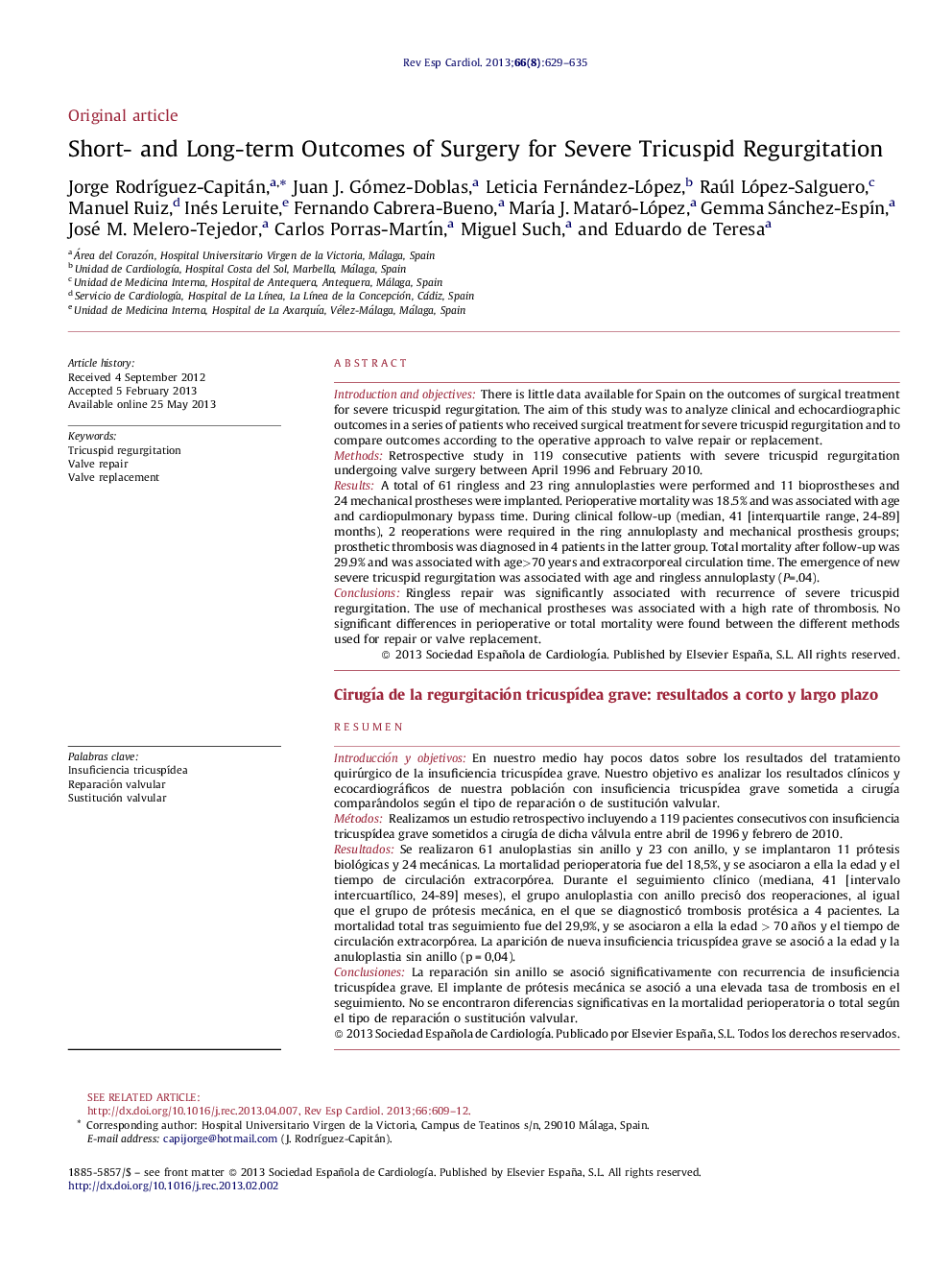| Article ID | Journal | Published Year | Pages | File Type |
|---|---|---|---|---|
| 3016682 | Revista Española de Cardiología (English Edition) | 2013 | 7 Pages |
Introduction and objectivesThere is little data available for Spain on the outcomes of surgical treatment for severe tricuspid regurgitation. The aim of this study was to analyze clinical and echocardiographic outcomes in a series of patients who received surgical treatment for severe tricuspid regurgitation and to compare outcomes according to the operative approach to valve repair or replacement.MethodsRetrospective study in 119 consecutive patients with severe tricuspid regurgitation undergoing valve surgery between April 1996 and February 2010.ResultsA total of 61 ringless and 23 ring annuloplasties were performed and 11 bioprostheses and 24 mechanical prostheses were implanted. Perioperative mortality was 18.5% and was associated with age and cardiopulmonary bypass time. During clinical follow-up (median, 41 [interquartile range, 24-89] months), 2 reoperations were required in the ring annuloplasty and mechanical prosthesis groups; prosthetic thrombosis was diagnosed in 4 patients in the latter group. Total mortality after follow-up was 29.9% and was associated with age>70 years and extracorporeal circulation time. The emergence of new severe tricuspid regurgitation was associated with age and ringless annuloplasty (P=.04).ConclusionsRingless repair was significantly associated with recurrence of severe tricuspid regurgitation. The use of mechanical prostheses was associated with a high rate of thrombosis. No significant differences in perioperative or total mortality were found between the different methods used for repair or valve replacement.
ResumenIntroducción y objetivosEn nuestro medio hay pocos datos sobre los resultados del tratamiento quirúrgico de la insuficiencia tricuspídea grave. Nuestro objetivo es analizar los resultados clínicos y ecocardiográficos de nuestra población con insuficiencia tricuspídea grave sometida a cirugía comparándolos según el tipo de reparación o de sustitución valvular.MétodosRealizamos un estudio retrospectivo incluyendo a 119 pacientes consecutivos con insuficiencia tricuspídea grave sometidos a cirugía de dicha válvula entre abril de 1996 y febrero de 2010.ResultadosSe realizaron 61 anuloplastias sin anillo y 23 con anillo, y se implantaron 11 prótesis biológicas y 24 mecánicas. La mortalidad perioperatoria fue del 18,5%, y se asociaron a ella la edad y el tiempo de circulación extracorpórea. Durante el seguimiento clínico (mediana, 41 [intervalo intercuartílico, 24-89] meses), el grupo anuloplastia con anillo precisó dos reoperaciones, al igual que el grupo de prótesis mecánica, en el que se diagnosticó trombosis protésica a 4 pacientes. La mortalidad total tras seguimiento fue del 29,9%, y se asociaron a ella la edad > 70 años y el tiempo de circulación extracorpórea. La aparición de nueva insuficiencia tricuspídea grave se asoció a la edad y la anuloplastia sin anillo (p = 0,04).ConclusionesLa reparación sin anillo se asoció significativamente con recurrencia de insuficiencia tricuspídea grave. El implante de prótesis mecánica se asoció a una elevada tasa de trombosis en el seguimiento. No se encontraron diferencias significativas en la mortalidad perioperatoria o total según el tipo de reparación o sustitución valvular.
